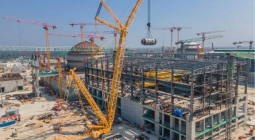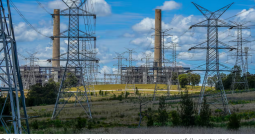Ontario’s ‘Clean Energy Superpower’ Plan Puts Nuclear Ahead of Least-Cost Options, Analysts Warn

Ontario’s newly-minted energy minister Stephen Lecce is coming under fire for recent musings about turning the province into a “clean energy superpower”, with analysts scorching his decision to include nuclear generation in the mix and calling for some coherent system planning before making that decision.
In an interview with the Globe and Mail’s Adam Radwanski not long after he took over his new portfolio June 6, Lecce “touted initiatives he inherited, including the country’s largest investment to date in grid-scale battery storage, and a coming procurement of wind and solar power,” Radwanski wrote late last month. Those words “might come as a relief to people who worried his appointment to the job last month might signal a return to the anti-decarbonization positioning of Premier Doug Ford’s early days in office.”
But Lecce also “signalled an enhanced focus on nuclear power,” Radwanski added. “That means not just refurbishments and construction of a small modular reactor (SMR), which are under way, but also building new large-scale reactors—all of which he framed as essential to domestic needs and export opportunities.”
At a Canada-U.S. nuclear meeting on the sidelines of last month’s NATO summit, “energy security was at the core—an issue that overwhelmingly unites Democrats and Republicans in the U.S.,” Lecce told Radwanski. “There is an acute awareness that, now more than ever, we must decouple our dependence on despotic regimes abroad.”
He said that meant an “opportunity to emphasize that, among nations who share democratic values, Ontario has the technological expertise and capability to build, refurbish, and expand nuclear, on time and on budget.”
“It really underscores both Canada and the U.S.’s national and economic interests—that we work together to harness this capability to produce clean energy,” Lecce told The Canadian Press, adding that Russia’s invasion of Ukraine had cast a light on Canada as a reliable supplier of uranium.
Lecce’s “superpower” language wasn’t very different from the line of argument he would have used in a former job, after then-prime minister Stephen Harper hired him out straight of university to serve as his deputy director of communications, then his director of media relations.
Here We Go Again
While the refurbishment project now under way at the Darlington nuclear station east of Toronto has been making headlines by apparently running on time and on budget, that’s precisely because it’s so unusual for nuclear plants of any kind to avoid serious delays and cost overruns.
Last year, Corporate Knights Research Director Ralph Torrie recalled the more than C$10 billion in written-off costs for the original Darlington construction project that essentially bankrupted Ontario Hydro, then the second-largest power utility in North America—based on projections of future electricity demand that never materialized in the real world.
“History continues to outrun electricity planning in Ontario, as it has been doing for decades now, and we all pay for the overshoots and malinvestment that result,” Torrie wrote at the time. “We cannot afford another round of ill-conceived commitments to multi-billion-dollar megaprojects that will be left half-built and stranded just as technology, market forces, and common sense converge on a smarter, less expensive, more distributed and renewables-based energy system.”
Energy system analysts Mark Winfield of York University and David Schlissel of the Institute for Energy Economics and Financial Analysis said they see no prospect that an expanded nuclear program in Ontario will stay within budget, compete with more affordable renewable energy and energy efficiency options, or deliver in time to meet a rapid decarbonization deadline. (Mark Winfield and Evan Pivnick, quoted below, are both members of the community sounding board for The Energy Mix’s Heat & Power edition.)
Experience with recent conventional nuclear projects in North America and Western Europe “points to a continuing pattern of massive cost overruns and delays on the time scales of decades,” Winfield told The Energy Mix in an email. “One of the core problems with nuclear is that it does not see a significant learning curve—costs just keep going up, unlike renewables and storage, where you see performance improve and costs fall as experience is gained, and supply chains and project management and construction become more efficient.”
A ‘Rational Approach’
Given serious uncertainties around Ontario’s path to decarbonization and how much electricity the province will eventually need, Winfield said a more “rational approach” would deploy “lower-risk, lower-impact, and more flexible and scalable options” like demand-side management, energy efficiency, distributed energy resources (DERs), and renewable energy with energy storage, “and only consider higher-risk, higher-impact, high lock-in resources after that.”
But he said that won’t happen in a province that has “no planning process within which these options can be assessed in an open and independent manner.”
“You want to do the cheapest thing first, right?” Schlissel agreed in an interview this week. “And you want to have flexibility if the big, future demand that is being projected today is not realized.”
By contrast, while Ontario is being “very closed-mouthed” about the small modular nuclear reactor (SMR) under construction at Darlington, costs elsewhere are already rising, making the technology far more expensive than renewables.
“It’s clear the cost has gone up dramatically, and there’s no reason to expect the future will be any different than the past,” he said. “Is it possible? Yes, it’s possible that some (SMRs) will get online. Is it possible that they’ll be cheap? Yes. But what standard of proof do you have? Yes, it’s possible, but there’s a lot of evidence arguing against that happening.”
While nuclear proponents have been talking about their technology co-existing with renewables, Schlissel said new nuclear capacity would be more likely to crowd cheaper, cleaner renewables out of the system.
“Nuclear plants are not economical unless you run them flat out,” he explained. Given the high cost of those projects, and the need to protect ratepayers from higher electricity rates to the extent possible, “there will be none of this about supplementing wind and solar, that when the sun doesn’t shine or the wind doesn’t blow we’ll crank up the nuke.”
Where the Rubber Hits the Road
Evan Pivnick, clean energy program manager at Clean Energy Canada, said Lecce is sending the right overall message. But that’s not the same thing as delivering results.
“In general, I think the ambition and the rhetoric around positioning Ontario as a clean energy superpower and highlighting the role of clean electricity for households or industry is actually what we want to see more and more provinces do,” he said. But “where the rubber hits the road, Ontario has a little bit more of a mixed record.”
While Ontario’s Independent Electricity System Operator (IESO) commissioned a pathways assessment to map a cost-effective energy future for the province, “it’s unclear how many of those scenarios centred net-zero by 2050,” he said. And since then, “despite some meaningful and truly credible forward steps on clean electricity, they still haven’t connected the dots between climate targets and energy.” So the same province that launched Canada’s biggest-ever energy storage procurement and committed to 5,000 megawatts of new renewable energy capacity also overturned an independent regulator’s bid to protect new homeowners from the long-term cost of building new gas infrastructure.
The 40-year payback on those gas lines “takes us well past 2050,” Pivnick said. “This is where we’ve been pushing for quite a while for an energy strategy that features net-zero by 2050 at the very least. Then we know what we’re aiming for and we can hold the decisions we’re making against that. Rather than relying on rhetoric that is quite positive, we get to make sure those actions are actually supported.”
Pivnick said there’s “no question nuclear will play a role, and possibly an expanding role,” as electricity demand increases. But those decisions begin with what amounts to a least-cost energy strategy.
“In other jurisdictions around the world, the approaches that best protect affordability and cost start out with maximizing the role of energy efficiency, distributed energy resources, and renewables,” he said. “Where those are unable to meet energy or reliability needs, long-term and cost-effectively, we then start to move up the list of other, more costly sources.”
Through that lens, he said it’s fine to experiment with SMRs that might have a future role to play. But “predicating our future on making nuclear the first tranche or approach? That has potential risk to it, and we’ve been pretty clear that if this government is going to centre nuclear as they are, they need to have a backup plan.” That would mean developing the ability to “build out renewables, focus on energy efficiency, demand-side management, DERs, that will actually bring down the cost for consumers and offer new ways to drive affordability. And then we’ll see” what the system needs.
The future Ontario should want to avoid, he added, is the one where the need for electricity rises so fast that consumer demand competes against industrial uses for the available electrons.
“In that scenario where you have room for real take-off (of demand), there’s going to be room for everything,” and if SMRs can be cost effective “then, yeah, they may very well play a role,” he said. But that will make it all the more important to sequence the various options, with first call on the ones that cost the least. Last year, analysis by Clean Energy Canada concluded that solar and wind farms with battery backup were already cheaper to build than new gas plants in Ontario and Alberta, much less nuclear projects, with the cost of renewables expected to fall sharply this decade.





